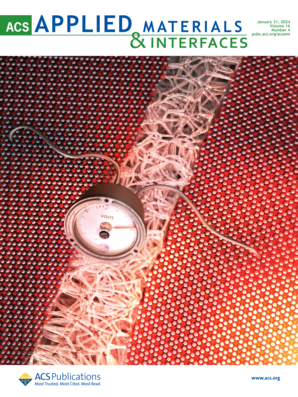Structure-Induced Selectivity of Hydroxylated Covalent Organic Framework Nanofibers for Advanced Sensing Applications: An Experimental and Density Functional Theory Study
IF 8.3
2区 材料科学
Q1 MATERIALS SCIENCE, MULTIDISCIPLINARY
引用次数: 0
Abstract
This study reports on the rational design of hydroxyl-functionalized covalent organic framework nanofibers (HO-COFs: PyTA-2,3-NA(OH)2 and PyTA-2,6-NA(OH)2) by a scalable solvothermal method. The resulting PyTA-2,3-NA(OH)2 HO-COF is more hydrophilic than the PyTA-2,6-NA(OH)2 HO-COF, which can effectively enhance the sensitivity of the sensor toward basic ethylenediamine (EDA). The fabricated HO-COF nanofiber-based quartz crystal microbalance sensor exhibits a rapid sensing response and a distinguished selectivity toward EDA vapor, arising from the strong hydrogen bonding interactions with the NH2 groups of EDA, as investigated by a wide variety of chemical analysis techniques and density functional theory calculations. The presence of exposed neighboring hydroxyl groups that face the same direction in the PyTA-2,3-NA(OH)2 HO-COF and the NH2 groups present in EDA exhibited efficient interactions. The PyTA-2,3-NA(OH)2 nanofiber with neighboring hydroxyl groups exhibits 1.6 times higher sensitivity to 100 ppm (ppm) EDA than PyTA-2,6-NA(OH)2 with hydroxyl groups in opposite directions, with a low limit of detection of 2.9 ppm. The PyTA-2,3-NA(OH)2 nanofiber structure has abundant active neighboring hydroxyl groups facing the same direction, making them favorable active sites for binding EDA molecules through strong hydrogen bond interactions. The color of the HO-COF changed after exposure to EDA vapor, as investigated by colorimetric assessment and naked-eye detection. These HO-COF nanofibers exhibit remarkable selectivity for EDA in the presence of other interfering chemical vapors and show high stability with only a 6.4% drop in sensitivity after 6 months. The adsorption of EDA on PyTA-2,3-NA(OH)2 nanofibers follows a pseudo-first-order kinetic model, with an adsorption rate about 8.0 times faster than PyTA-2,6-NA(OH)2 nanofibers. The findings of this study highlight the potential use of COFs, particularly those nanofibers with close neighboring hydroxyl groups, as effective sensing materials for the selective detection of harmful EDA.

用于高级传感应用的羟基化共价有机框架纳米纤维的结构诱导选择性:实验和密度泛函理论研究
本文报道了用可扩展溶剂热法设计羟基功能化的共价有机框架纳米纤维(HO-COFs: pyta -2,3- na (OH)2和pyta -2,6- na (OH)2)。所得的pyta -2,3- na (OH)2 HO-COF比pyta -2,6- na (OH)2 HO-COF更亲水,可有效提高传感器对碱式乙二胺(EDA)的灵敏度。制备的HO-COF纳米纤维石英晶体微平衡传感器显示出快速的传感响应和对EDA蒸气的独特选择性,这是由于EDA与NH2基团的强氢键相互作用,通过各种化学分析技术和密度泛函数理论计算进行了研究。pyta -2,3- na (OH)2 HO-COF中相同方向的暴露邻近羟基与EDA中存在的NH2基团表现出有效的相互作用。具有相邻羟基的pyta -2,3- na (OH)2纳米纤维对100 ppm (ppm) EDA的灵敏度比具有相反方向羟基的pyta -2,6- na (OH)2高1.6倍,低检出限为2.9 ppm。pyta -2,3- na (OH)2纳米纤维结构具有丰富的面向同一方向的活性邻近羟基,使其成为通过强氢键相互作用结合EDA分子的有利活性位点。通过比色法和肉眼检测研究了暴露于EDA蒸汽后HO-COF的颜色变化。这些HO-COF纳米纤维在其他干扰化学气相存在的情况下对EDA具有显著的选择性,并且在6个月后灵敏度仅下降6.4%,具有很高的稳定性。EDA在pyta -2,3- na (OH)2纳米纤维上的吸附符合准一级动力学模型,吸附速率比pyta -2,6- na (OH)2纳米纤维快约8.0倍。本研究结果强调了COFs的潜在用途,特别是那些具有邻近羟基的纳米纤维,作为选择性检测有害EDA的有效传感材料。
本文章由计算机程序翻译,如有差异,请以英文原文为准。
求助全文
约1分钟内获得全文
求助全文
来源期刊

ACS Applied Materials & Interfaces
工程技术-材料科学:综合
CiteScore
16.00
自引率
6.30%
发文量
4978
审稿时长
1.8 months
期刊介绍:
ACS Applied Materials & Interfaces is a leading interdisciplinary journal that brings together chemists, engineers, physicists, and biologists to explore the development and utilization of newly-discovered materials and interfacial processes for specific applications. Our journal has experienced remarkable growth since its establishment in 2009, both in terms of the number of articles published and the impact of the research showcased. We are proud to foster a truly global community, with the majority of published articles originating from outside the United States, reflecting the rapid growth of applied research worldwide.
 求助内容:
求助内容: 应助结果提醒方式:
应助结果提醒方式:


